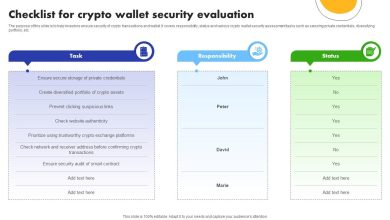Future Trends in Cryptocurrency Wallets

- Introduction to Cryptocurrency Wallets
- Evolution of Cryptocurrency Wallets
- Security Features in Modern Cryptocurrency Wallets
- Integration of Biometric Authentication in Wallets
- Emerging Trends in Multi-Currency Wallets
- The Role of Decentralized Exchanges in the Future of Wallets
Introduction to Cryptocurrency Wallets
Cryptocurrency wallets are essential tools for anyone looking to store, send, or receive digital assets securely. These wallets come in various forms, including hardware, software, and paper wallets. Each type offers its own set of features and security measures to protect your funds.
Hardware wallets, such as Ledger or Trezor, are physical devices that store your cryptocurrency offline, making them less vulnerable to hacking. Software wallets, on the other hand, are applications that can be downloaded onto your computer or smartphone for convenient access to your funds. Paper wallets are physical documents that contain your public and private keys, providing an extra layer of security by keeping your information offline.
When choosing a cryptocurrency wallet, it’s essential to consider factors such as security, ease of use, and compatibility with different cryptocurrencies. Some wallets support a wide range of digital assets, while others are designed for specific coins. It’s crucial to do your research and choose a wallet that meets your needs and preferences.
As the cryptocurrency market continues to evolve, we can expect to see new trends and innovations in wallet technology. Developers are constantly working to improve security measures and user experience, making it easier and safer to manage your digital assets. Stay informed about the latest developments in cryptocurrency wallets to ensure that your funds are protected and easily accessible.
Evolution of Cryptocurrency Wallets
The evolution of cryptocurrency wallets has been a fascinating journey, with advancements in technology driving significant changes in how users store and manage their digital assets. In the early days of cryptocurrency, wallets were primarily software applications that allowed users to securely store their private keys and interact with the blockchain. However, as the popularity of cryptocurrencies grew, so did the demand for more secure and user-friendly wallet solutions.
One of the most significant developments in the evolution of cryptocurrency wallets has been the emergence of hardware wallets. These physical devices store users’ private keys offline, providing an extra layer of security against hacking and malware attacks. Hardware wallets have become increasingly popular among cryptocurrency enthusiasts who prioritize security and peace of mind when it comes to storing their digital assets.
Another trend in the evolution of cryptocurrency wallets is the rise of mobile wallets. These smartphone applications allow users to access their digital assets on the go, making it easier than ever to make transactions and manage their cryptocurrency portfolios. Mobile wallets are convenient and user-friendly, making them a popular choice for casual cryptocurrency users who value accessibility and ease of use.
In addition to hardware and mobile wallets, there has been a growing interest in multi-signature wallets. These wallets require multiple private keys to authorize a transaction, adding an extra layer of security and reducing the risk of unauthorized access. Multi-signature wallets are particularly popular among businesses and organizations that require a high level of security for their cryptocurrency holdings.
Overall, the evolution of cryptocurrency wallets has been driven by a desire for increased security, convenience, and accessibility. As technology continues to advance, we can expect to see even more innovative wallet solutions that cater to the diverse needs of cryptocurrency users. Whether you prefer the security of a hardware wallet, the convenience of a mobile wallet, or the added security of a multi-signature wallet, there is a wallet solution out there to suit your needs.
Security Features in Modern Cryptocurrency Wallets
Modern cryptocurrency wallets come equipped with a variety of **security features** to ensure the safety of users’ digital assets. These **security measures** are essential in protecting against **cyber threats** and unauthorized access. Some of the **security features** found in **cryptocurrency wallets** include:
- **Two-factor authentication**: This adds an extra layer of **security** by requiring users to provide two different forms of **identification** before accessing their **wallet**.
- **Biometric authentication**: Some **wallets** use fingerprint or facial recognition technology to verify the **identity** of the user.
- **Multi-signature support**: This feature requires multiple **signatures** to authorize a **transaction**, adding an extra level of **security**.
- **Hierarchical deterministic (HD) wallets**: These **wallets** generate a new **public key** for each **transaction**, making it harder for **hackers** to track **transactions**.
- **Secure enclave**: Some **wallets** store **private keys** in a secure enclave, isolated from the rest of the device’s **software**.
By incorporating these **security features**, **cryptocurrency wallets** are able to provide users with peace of mind knowing that their **digital assets** are safe and secure. As **cyber attacks** become more sophisticated, it is crucial for **wallet** developers to stay ahead of the curve and continue to innovate in the realm of **security**.
Integration of Biometric Authentication in Wallets
In the realm of cryptocurrency wallets, one emerging trend that is gaining traction is the integration of biometric authentication. This technology allows users to access their wallets using unique physical characteristics such as fingerprints, facial recognition, or iris scans. By incorporating biometric authentication into wallets, users can enjoy an added layer of security that is difficult to replicate or hack.
Biometric authentication offers a convenient and secure way for users to access their cryptocurrency wallets without the need to remember complex passwords or phrases. This technology not only enhances security but also streamlines the user experience, making it easier and faster to access funds. With the increasing concerns around cybersecurity and identity theft, biometric authentication provides a reliable solution to safeguard users’ assets.
Moreover, the integration of biometric authentication in wallets aligns with the growing trend of personalization and customization in the cryptocurrency space. By allowing users to use their unique physical characteristics to access their wallets, this technology adds a personal touch to the user experience. It also reflects the industry’s commitment to innovation and staying ahead of the curve in terms of security measures.
Overall, the integration of biometric authentication in cryptocurrency wallets represents a significant step forward in enhancing security and user experience. As the technology continues to evolve and become more widespread, we can expect to see even more advanced features and capabilities being integrated into wallets to ensure the safety and convenience of users’ assets.
Emerging Trends in Multi-Currency Wallets
In recent years, there has been a noticeable shift towards the use of multi-currency wallets in the cryptocurrency space. These wallets allow users to store and manage multiple cryptocurrencies in a single platform, providing convenience and flexibility.
One of the emerging trends in multi-currency wallets is the integration of decentralized exchanges (DEX) directly into the wallet interface. This allows users to trade cryptocurrencies without having to transfer funds to an external exchange, reducing the risk of hacks and scams.
Another trend is the implementation of advanced security features such as biometric authentication and multi-signature transactions. These features help to enhance the security of the wallet and protect users’ funds from unauthorized access.
Furthermore, some multi-currency wallets are now offering staking services, allowing users to earn rewards by holding their cryptocurrencies in the wallet. This provides an additional incentive for users to keep their funds in the wallet rather than transferring them to an external staking platform.
Overall, the future of multi-currency wallets looks promising, with new features and functionalities being added to enhance the user experience and security. As the cryptocurrency market continues to evolve, multi-currency wallets are likely to play an increasingly important role in the ecosystem.
The Role of Decentralized Exchanges in the Future of Wallets
Decentralized exchanges (DEXs) are playing an increasingly important role in the future of cryptocurrency wallets. These exchanges allow users to trade directly from their wallets without the need for a centralized intermediary. This not only enhances security by reducing the risk of hacks or fraud, but also gives users more control over their funds.
One of the key advantages of DEXs is their ability to facilitate peer-to-peer transactions, enabling users to trade directly with one another. This eliminates the need for a middleman, reducing transaction fees and increasing the speed of transactions. Additionally, DEXs are often more resistant to censorship and government intervention, making them an attractive option for users who value privacy and autonomy.
As the popularity of DEXs continues to grow, we can expect to see more integration with cryptocurrency wallets. This will make it easier for users to access decentralized trading directly from their wallets, further streamlining the user experience. With the rise of decentralized finance (DeFi), DEXs are likely to play an even larger role in the future of wallets, offering users a wide range of financial services without the need for traditional banks or financial institutions.



